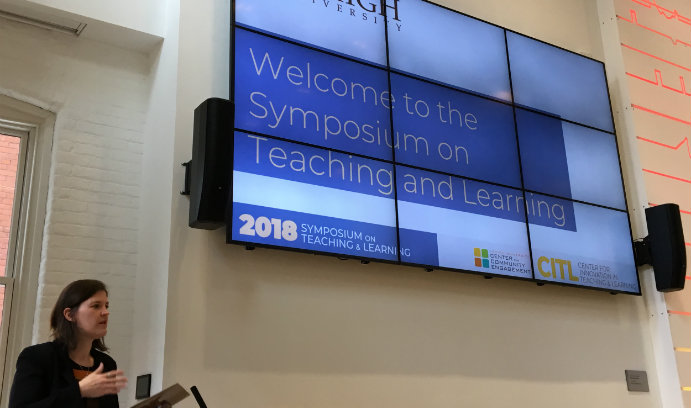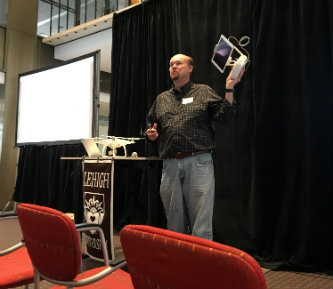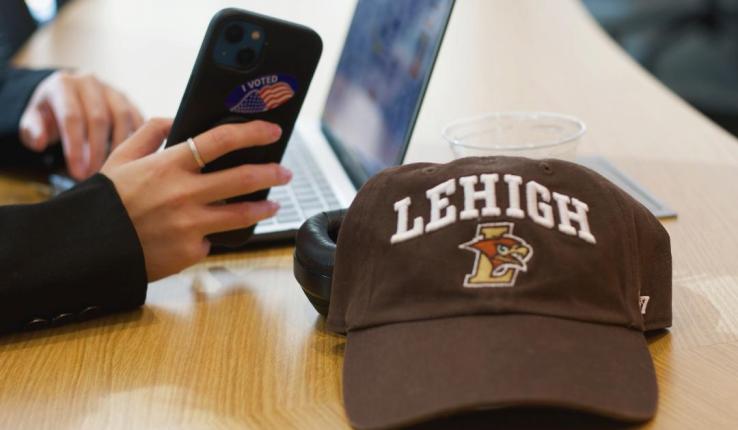Sharing Ideas, Inspiring Change

Sarah Stanlick, professor of practice in sociology and anthropology and director of the Center for Community Engagement, welcomes attendees.
Journalism students using drones to tell stories. Biology students exploring the body in virtual reality. Urban studies students using outdoor spaces as labs for testing ideas to improve city life. Students in organic chemistry making tutorial videos for their peers.
Lehigh faculty, students and staff shared such techniques and research methods—and myriad other unique approaches to education—at the 2018 Symposium on Teaching and Learning. The two-day symposium, held April 11-12 in partnership with the Center for Community Engagement (CCE) and the Center for Innovation in Teaching and Learning (CITL), featured more than 40 presentations across disciplines.
“It’s a great opportunity for faculty, staff and students to see the process that instructors and students go through when they try to bring new approaches into the classroom,” said Greg Reihman, associate vice provost and CITL director.
“There’s never a magic-wand moment where suddenly someone’s just doing something different,” he said. “Often times it requires a lot of careful thought, careful implementation, paying attention to what’s working, what’s not, and then, most importantly, that process of feeding it back to other members of the community.”
In 15-minute and lightning-round presentations, participants talked about techniques that are proving to be successful in teaching complex concepts and new skills and in better preparing students for careers after graduation. The symposium also highlighted high-quality research being done in partnership with the community, including sustainable development projects and arts education.
“My hope is that over the two days people have their eyes open to some really interesting, innovative pedagogues, the fact that research can be really impactful outside of the university, that there are partnerships and ethics and humility that need to be brought into these lifelong learning collaborations and that there is power in higher ed to be world-changing,” said Sarah Stanlick, professor of practice in sociology and anthropology and director of the CCE.
“It’s both process and product,” she said. “So people get to share the things that they’ve learned, they get to share best practices, the stumbling as well.”
Among the presenters:
Jeremy Littau, associate professor of journalism, said students in a class he co-teaches with professor of practice Matt Veto are learning to effectively operate drones to help in news gathering and storytelling, including using drones to give a bird’s-eye perspective of Lehigh architecture students building a footbridge to connect North and South Bethlehem.
Professor of Practice Karen Beck Pooley said students in her urban planning classes literally walked the streets of Bethlehem and talked to residents before proposing projects so that they could have a better understanding of how their projects would impact the community. Students created parklets, or miniature parks, to promote walkability and for use in other ways.
Katie Hoffman, a professor of practice in biological sciences, considered how biology topics could be creatively and visually presented. She incorporated virtual reality into one of her courses. Students, she said, responded positively.
Suzanne Fernandez, director of organic chemistry, had her students create a library of video tutorials on organic chemistry topics. Not only were the tutorials a resource for fellow students, she said, those who created the tutorials said they had learned the material more thoroughly.
The symposium opened with CCE’s Stanlick sitting down with sociology professor Judith Lasker, author of Hoping to Help: The Promises and Pitfalls of Global Health Volunteering, for a conversation about community engagement and the public purpose of higher education.
Lasker’s book sheds light on the problems that emerge when good-intentioned volunteers show cultural insensitivity and self-serving behavior.
Lasker talked about the challenges of community-based research. She said she feels “very strongly” that such research needs to be done better, that there needs to be an exchange with community members, that researchers can’t take advantage of other people’s situations to promote their own work and reputation. She said researchers need to make connections that are respectful and honest.
When Stanlick asked whether a community’s voice needs to drive the research that’s being done globally and locally, Lasker concurred. She added, however, that she’s encouraged because people are paying attention, communities are pushing back and universities are recognizing the scope of their responsibilities.
“I think the conversation is shifting,” she said.
Organizers of the symposium said the presentations were well received. Several attendees indicated that they would consider incorporating some of the teaching techniques into their classrooms or adapt what was presented.
The presentations can be viewed online here.
Photos by Kathleen Frederick
Posted on:








